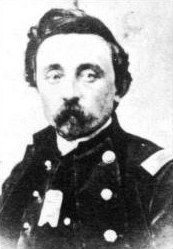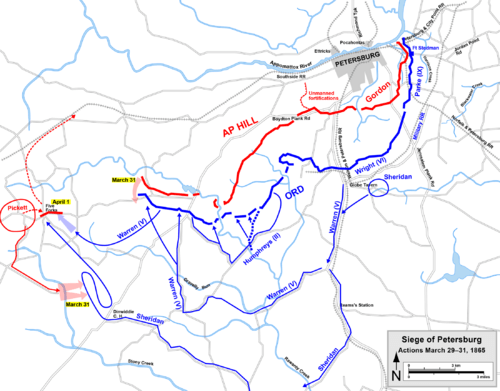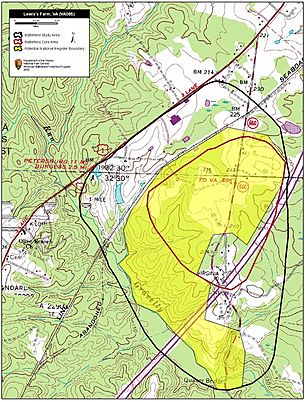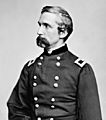Battle of Lewis's Farm facts for kids
Quick facts for kids Battle of Lewis's Farm |
|||||||
|---|---|---|---|---|---|---|---|
| Part of the American Civil War | |||||||
|
|||||||
| Belligerents | |||||||
| Commanders and leaders | |||||||
| Gouverneur K. Warren Joshua Chamberlain |
Bushrod Johnson | ||||||
| Strength | |||||||
| 17,000 | 8,000 | ||||||
| Casualties and losses | |||||||
| 381 | 371 | ||||||
The Battle of Lewis's Farm was a fight during the American Civil War. It happened on March 29, 1865, in Dinwiddie County, Virginia. This battle was part of the final push by the Union Army to capture Petersburg, Virginia and Richmond. These cities were very important to the Confederates.
The Union Army was led by Lieutenant General Ulysses S. Grant. They wanted to push the Confederates out of their strong defenses. Many historians see this battle as the start of the Appomattox Campaign. This campaign ended with the surrender of General Robert E. Lee's Confederate army on April 9, 1865.
On the morning of March 29, 1865, two Union army groups moved. These were the V Corps, led by Major General Gouverneur K. Warren, and the II Corps, led by Major General Andrew A. Humphreys. They moved southwest of Petersburg, aiming for the end of the Confederate lines. The Confederates in this area were led by Lieutenant General Richard H. Anderson. His group included Major General Bushrod Johnson's division.
As Warren's troops marched north on Quaker Road, they met Confederate soldiers. Brigadier General Joshua Chamberlain's Union brigade led the attack. They fought three Confederate brigades from Johnson's division at Lewis Farm. Union troops, with help from artillery and other regiments, pushed the Confederates back. They captured an important road junction. Chamberlain was wounded but kept fighting. Union Colonel Alfred L. Pearson later received the Medal of Honor for his brave actions.
Both sides had similar numbers of casualties. The Union lost 381 soldiers, and the Confederates lost 371. By the end of the battle, the Union V Corps held a key spot. This was where Quaker Road met Boydton Plank Road. Soon after, Major General Philip Sheridan's cavalry arrived at Dinwiddie Court House. This cut off another part of the Boydton Plank Road. The Union forces were now very close to the Confederate lines. They were ready to attack the Confederate side, especially at Five Forks. This area was important because it controlled the last two railroad lines to Petersburg and Richmond.
After this battle, the Confederates had to leave Petersburg and Richmond on April 2–3, 1865. They moved west, fighting smaller battles along the way. After a big defeat at the Battle of Sailor's Creek, General Lee surrendered his army to General Grant. This happened on April 9, 1865, at Appomattox Court House. By June 1865, all Confederate armies had surrendered.
Contents
Why the Battle Happened
The War in the East
The Battle of Lewis's Farm was part of the larger Richmond–Petersburg Campaign. This campaign lasted for 292 days, from June 1864 to April 1865. It is often called the Siege of Petersburg.
In June 1864, Union forces tried to capture Petersburg but failed. So, General Grant decided to use a different plan. He wanted to wear down the Confederate army. He also aimed to cut off their supplies and supply routes to Petersburg and Richmond. This would force the Confederates to spread their soldiers out, making their defenses weaker.
Throughout 1864 and early 1865, Grant slowly moved his army west. This forced the Confederates to stretch their lines even more. Lee's army was running out of men and supplies. He knew they could not defend Petersburg and Richmond forever. Especially with more Union soldiers coming. These included cavalry from the Shenandoah Valley and armies from North Carolina.
After the Battle of Hatcher's Run in February 1865, Lee had very few extra soldiers. He realized his army might have to leave Petersburg and Richmond. His plan was to get food and supplies from other cities. Then, he hoped to join forces with General Joseph E. Johnston's army in North Carolina. Together, they might defeat the Union army there.
Lee also approved a plan by Major General John Brown Gordon. Gordon wanted to attack the Union lines near Fort Stedman. This would force Grant to shorten his lines. It might give Lee's army a chance to escape west.
However, the Confederate attack on Fort Stedman on March 25, 1865, failed. The Union army fought back and recaptured the fort. The Confederates lost about 4,000 soldiers. This was a huge loss for them. After this defeat, Lee knew he could not split his army. He also knew Grant would soon attack the last Confederate supply lines. These were the Southside Railroad and the Boydton Plank Road.
Grant's Plan for Attack
General Grant had already planned a major attack for March 29, 1865. The defeat at Fort Stedman did not change his mind. Grant wanted Sheridan's cavalry to cut the remaining railroads. These were the Southside Railroad and the Richmond and Danville Railroad. He also wanted his infantry to push the Confederates out of their positions.
Grant told Sheridan to lead his cavalry around the Confederate right side. If the Confederates came out to fight, Sheridan would have infantry support. If not, Sheridan should destroy the railroads. Then he could either return to Petersburg or join General William Tecumseh Sherman in North Carolina.
Grant also ordered two infantry groups from the Army of the Potomac to help Sheridan. These were Warren's V Corps and Humphreys' II Corps. They were to protect Sheridan's right side. Grant wanted these infantry groups to go around the Confederate defenses. This would stop the Confederates from interfering with Sheridan's mission.
On the night of March 27–28, Major General Edward Ord secretly moved Union troops. These soldiers came from the Richmond lines to fill in the Petersburg lines. This allowed the II Corps to move and support Sheridan. The Confederates defending Richmond did not notice this movement. This meant Lee could not easily move more soldiers to stop Grant's attack.
The Battle Begins
On March 29, Warren's V Corps, with over 17,000 men, started moving early. They marched west on Vaughan Road. Warren reported that Dinwiddie Court House was not defended. General George Meade, who was in charge of the Army of the Potomac, ordered Warren to advance on Quaker Road. Warren was told to connect with the II Corps on his right. At first, Warren only sent Brigadier General Joshua Chamberlain's brigade up Quaker Road. Later, he sent more troops after a second order from Meade.
The II Corps also moved, making sure to keep close to the XXIV Corps. This prevented any gaps in the Union lines. Meade wanted the V Corps to move up Quaker Road to keep the Union forces connected.
Chamberlain's brigade marched north on Quaker Road. After about 1.5 miles, his scouts reported trouble. The bridge over Gravelly Run was destroyed. Confederates were dug in on the other side.
Confederate Lieutenant General Richard H. Anderson was in charge of the Confederate right side. When he heard about the Union advance, he ordered Major General Bushrod Johnson to push them back. Three Confederate brigades moved south on Quaker Road and Boydton Plank Road to carry out this order.
The Fight at Lewis's Farm
First Clashes
Chamberlain's men attacked the Confederates. He sent the 198th Pennsylvania Infantry to the right to distract them. Meanwhile, he led the 185th New York Volunteer Infantry across Gravelly Run. They attacked the Confederate right side, leading to hand-to-hand combat. Both Union regiments were very large, with about 1,000 soldiers each. The rest of Chamberlain's brigade followed.
The Confederates fell back to the Lewis farmhouse clearing, about a mile north. After a brief stand there, they moved into the woods. Here, they were reinforced by other Confederate soldiers behind strong defenses. The Confederates pushed back the Union scouts but lost about 100 men as prisoners. Chamberlain brought up the rest of his men, and the Confederates returned to their defenses.
Chamberlain's Bravery

After a short break, Chamberlain's commander, Brigadier General Charles Griffin, told him the Confederate position must be taken. Chamberlain, on horseback, led a charge up Quaker Road. They aimed for a large sawdust pile that gave the Confederates cover. Chamberlain rode ahead of his men and became an easy target. He was wounded in the arm, and his horse was also hit.
Chamberlain briefly lost consciousness but soon recovered. He then rallied his Pennsylvania regiment, who were retreating from a Confederate charge. When his wounded horse could not continue, Chamberlain continued on foot. Several Confederate soldiers appeared and demanded his surrender. Chamberlain, who had lost his hat and wore a faded coat, pretended to be a Confederate officer. He led the Confederates back toward Union soldiers, who quickly captured them.
Union Wins the Day

Chamberlain saw his New York regiment being pushed back. He and his officers helped steady the men. Soon, they pushed the Confederates back with the help of Union artillery. The Confederates tried to go around the Union position, but the Union soldiers held strong. However, the Confederates then charged the Pennsylvania troops in the center. These Union soldiers were low on ammunition and began to slowly retreat.
Just as Chamberlain's line was falling back, help arrived. The 188th New York Volunteer Infantry Regiment and the 155th Pennsylvania Volunteer Infantry Regiment joined the fight. Colonel Edgar M. Gregory's brigade reinforced them. Colonel Alfred L. Pearson led the Pennsylvanians toward the sawdust pile. Pearson grabbed his regiment's flag and charged forward. His men followed, passing through the tired soldiers of the first brigade. Thirty-two years later, Pearson received the Medal of Honor for his actions at Lewis's Farm.
Seeing these new Union soldiers, the Confederates retreated. They went back to their main defenses along White Oak Road. They left behind wounded men and some who surrendered. Chamberlain then set up his men and the artillery around the Lewis farm buildings.
Chamberlain wrote that his brigade had fewer than 1,700 men. His reinforcements added about 1,000 more. He believed the Confederates had over 6,000 men in Johnson's Division. He said his brigade lost about a quarter of its men. He also noted that his brigade captured almost 200 prisoners. Modern estimates show 381 Union casualties and 371 Confederate casualties.
What Happened Next
Union Gains Ground
Warren's V Corps took a key position near the junction of Quaker Road and Boydton Plank Road. This allowed the Union Army to cut this important supply road. It also set them up to attack the White Oak Road Line. Sheridan's cavalry reached Dinwiddie Court House around 5:00 p.m. on March 29. They secured important roads in the area.
Grant's New Plan
The Confederates failed to press their attack at Lewis's Farm. They pulled back to their White Oak Road Line. This encouraged Grant. He decided to turn Sheridan's mission into a major attack. He wrote to Sheridan, "I now feel like ending the matter...."
Lee's Response
Lee had expected Grant to attack his right side. He had only about 6,000 cavalry and 5,000 infantry to extend his line. On March 29, Lee ordered Major General George Pickett to move his forces to protect Five Forks. This area was very important. Lee also ordered other generals to move their cavalry and infantry to reinforce Pickett. Lee hoped Pickett could extend the Confederate line to Five Forks.
However, a gap still existed between Pickett's forces and the main Confederate line. Lee ordered more troops to stand ready.
March 30, 1865: Rain and Skirmishes
Heavy rain fell all night on March 29 and continued the next day. This limited the fighting. Sheridan convinced Grant to keep pushing forward despite the weather. On March 30, half of Sheridan's cavalry fought with Confederate cavalry. They had some small clashes as they approached Five Forks.
Meanwhile, Warren's V Corps kept the Confederates busy in their White Oak Road Line. Warren pushed his troops forward to strengthen their hold on Boydton Plank Road. They dug in to protect the road. Humphrey's II Corps closed the gap between the Union forces.
The fighting and movements at Lewis's Farm on March 29 and 30 set the stage for bigger battles. These included the Battle of White Oak Road and the Battle of Dinwiddie Court House on March 31, 1865.
Images for kids
-
Major General Bushrod Johnson
-
Brigadier General Joshua Chamberlain
-
Colonel (Brevet Brigadier General) Alfred L. Pearson






